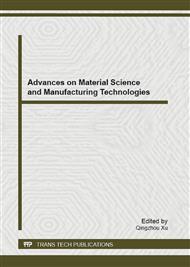[1]
Jiang JW, Babarao R, Hu ZQ, Molecular simulations for energy, environmental and pharmaceutical applications of nanoporous materials: from zeolites, etal-organic frameworks to protein crystals, Chemical Society Reviews. 40 (7) (2011) 3599-3612.
DOI: 10.1039/c0cs00128g
Google Scholar
[2]
Thi X T Sayle, Phuti E. Ngoepe, Dean C. Sayle, Simulating mechanical deformation in nanomaterials with application for energy storage in nanoporous architectures, ACS Nano. 3 (10) (2009) 3308-3314.
DOI: 10.1021/nn9009592
Google Scholar
[3]
Hiroyasu Furukawa, Omar M. Yaghi, Storage of hydrogen, Methane, and carbon dioxide in highly porous covalent organic frameworks for clean energy applications, J. Am. Chem. Soc. 131 (25) (2009) 8875-8883.
DOI: 10.1021/ja9015765
Google Scholar
[4]
Lilin He, Suresh M. Chathoth, Yuri B, Melnichenko, Small-angle neutron scattering characterization of the structure of nanoporous carbons for energy-related applications, Microporous and Mesoporous Materials. 149 (2012) 46-54.
DOI: 10.1016/j.micromeso.2011.08.035
Google Scholar
[5]
Yasutaka Nishida, Satoshi Itoh, A modeling study of porous composite microstructures for solid oxide fuel cell anodes, Electrochimica Acta. 56 (7) (2011) 2792-2800.
DOI: 10.1016/j.electacta.2010.12.055
Google Scholar
[6]
M Maidhily, N Rajalakshmi, K S Dhathathreyan, Electrochemical impedance diagnosis of micro porous layer in polymer electrolyte membrane fuel cell electrodes, International Journal of Hydrogen Energy. 36 (19) 2011 12352-12360.
DOI: 10.1016/j.ijhydene.2011.06.084
Google Scholar
[7]
Naiqing Zhang, Juan Li, Dan Ni, et al., Preparation of honeycomb porous La0.6Sr0.4Co0.2Fe0.8O3 −δ–Gd0.2Ce0.8O2−δ composite cathodes by breath figures method for solid oxide fuel cells, Applied Surface Science. 258 (1) (2011) 50-57.
DOI: 10.1016/j.apsusc.2011.08.004
Google Scholar
[8]
Joshua S. Preston, Richard S. Fu, Ugur Pasaogullari, et al., Consideration of the role of micro-porous layer on liquid water distribution in polymer electrolyte fuel cells, J. Electrochem. Soc. 158 (2) (2011) B239-B246.
DOI: 10.1149/1.3525626
Google Scholar
[9]
Yun Wang, Porous-Media Flow Fields for Polymer Electrolyte Fuel Cells: I. Low Humidity Operation, J. Electrochem. Soc. 156 (10) (2009) B1124-B1133.
DOI: 10.1149/1.3183781
Google Scholar
[10]
Yun Wang, Porous-Media Flow Fields for Polymer Electrolyte Fuel Cells: II. Analysis of Channel Two-Phase Flow, J. Electrochem. Soc. 156 (10) (2009) B1134-B1141.
DOI: 10.1149/1.3183785
Google Scholar
[11]
Minjeh Ahna, Yong-Hun Chob, Yoon-Hwan Choa, et al., Influence of hydrophilicity in micro- porous layer for polymer electrolyte membrane fuel cells, Electrochimica Acta. 56 (5) 2011 2450-2457.
DOI: 10.1016/j.electacta.2010.11.063
Google Scholar
[12]
S Pulloor Kuttanikkad, M Prat, J. Pauchet, Pore-network simulations of two-phase flow in a thin porous layer of mixed wettability: Application to water transport in gas diffusion layers of proton exchange membrane fuel cells, Journal of Power Sources. 196 (3) (2011) 1145-1155.
DOI: 10.1016/j.jpowsour.2010.09.029
Google Scholar
[13]
Martin Oschatz, Emanuel Kockrick, Marcus Rose, et al., A cubic ordered, mesoporous carbide- derived carbon for gas and energy storage applications, Carbon. 48 (2010) 3987-3992.
DOI: 10.1016/j.carbon.2010.06.058
Google Scholar
[14]
Jin Kim, Nicolas Cunningham, Development of porous carbon foam polymer electrolyte membrane fuel cell, Journal of Power Sources. 195 (8) (2010) 2291-2300.
DOI: 10.1016/j.jpowsour.2009.10.053
Google Scholar
[15]
Du He Yun, Wang Chen Hao, Hsu Hsin Cheng, et al., High performance of catalysts supported by directly grown PTFE-free micro-porous CNT layer in a proton exchange membrane fuel cell, Journal of Materials Chemistry. 21 (8) (2011) 2512-2516.
DOI: 10.1039/c0jm03215h
Google Scholar
[16]
Ma TY, Yuan ZY, Metal phosphonate hybrid mesostructures: Environmentally friendly multifunctional materials for clean energy and other applications, Chemsuschem. 4 (10) (2011) 1407-1419.
DOI: 10.1002/cssc.201100050
Google Scholar
[17]
Prabal Sapkota, Honggon Kim, An experimental study on the performance of a zinc air fuel cell with inexpensive metal oxide catalysts and porous organic polymer separators, Journal of Industrial and Engineering Chemistry. 16 2010 39-44.
DOI: 10.1016/j.jiec.2010.01.024
Google Scholar
[18]
Tienhoa Nguyen, XinWang, Multifunctional composite membrane based on a highly porous polyimide matrix for direct methanol fuel cells, Journal of Power Sources. 195 2010 1024-1030.
DOI: 10.1016/j.jpowsour.2009.08.049
Google Scholar
[19]
Zhi Ming, A new style nano-compound polymer material for H2 storage, World Plastic. 29 (7) (2011) 70.
Google Scholar
[20]
Sung Hyun Yuna, Jung Je Wooa, Seok Jun Seoa, et al., Sulfonated poly(2,6-dimethyl-1,4- phenylene oxide) (SPPO) electrolyte membranes reinforced by electrospun nanofiber porous substrates for fuel cells, Journal of Membrane Science. 367 ( 1-2) (2011) 296-305.
DOI: 10.1016/j.memsci.2010.11.017
Google Scholar
[21]
A. Eguizábal, J Lemus, M Urbiztondo,et al., Novel hybrid membranes based on polybenzimidazole and ETS-10 titanosilicate type material for high temperature proton exchange membrane fuel cells: A comprehensive study on dense and porous systems, Journal of Power Sources. 196 (21) 2011 8994-9007.
DOI: 10.1016/j.jpowsour.2011.03.006
Google Scholar


